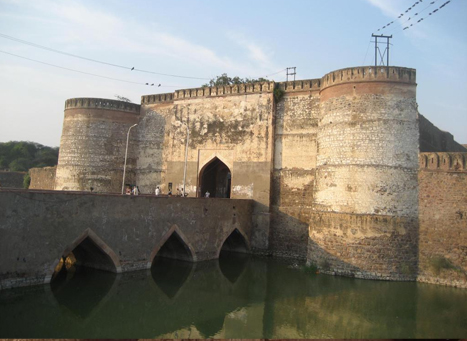Lohagarh Fort, nestled in the heart of Bharatpur, Rajasthan, stands as a formidable testament to the ingenuity and valor of the Jat rulers. Built in the early 18th century by Maharaja Suraj Mal, this “Iron Fort” lived up to its name, proving to be impregnable against numerous attacks, most notably those by the British.
A Fortress of Ingenuity and Resilience:
What truly sets Lohagarh Fort apart from other grand forts of Rajasthan is its unique and practical architecture, designed for maximum defense rather than ostentatious display. Unlike the stone and marble structures of other forts, Lohagarh was primarily constructed using mud and rubble. This unconventional choice proved to be its greatest strength. The thick mud walls, sometimes reaching up to 30 feet in thickness, had an astonishing ability to absorb cannonball impacts, rendering the enemy’s artillery ineffective. Cannonballs would simply sink into the pliable mud, losing their destructive force.
Adding another layer of defense, the fort is surrounded by a wide and deep moat, which was strategically filled with water and, according to some accounts, even crocodiles, making any direct assault incredibly challenging. This innovative design baffled attackers, and it is famously said that the British, despite launching 13 attempts to breach the fort, were never able to conquer it through direct assault. They eventually had to resort to a siege and negotiation to gain control.
Architectural Highlights and Inside the Fort:
While not adorned with the intricate carvings found in many Rajput palaces, Lohagarh Fort boasts a rugged charm and a blend of Rajput and Mughal architectural styles. The fort has two main gates:
- Ashtadhatu Gate: Located on the north side, this impressive gate is made of “ashtadhatu” (eight metals) and is a remarkable piece of craftsmanship. It’s believed to have been brought from Delhi as a war trophy by Maharaja Jawahar Singh.
- Chowburja Gate: This four-pillared gate faces south and provides another entry point to the fort.
Within the fort complex, visitors can explore several notable structures that offer a glimpse into the royal life and historical events:
- Kishori Mahal: Named after Maharaja Suraj Mal’s queen, this palace showcases a blend of architectural styles with arched windows and pillars.
- Mahal Khas and Kothi Khas: These served as the royal residence and administrative centers, reflecting a more functional and sturdy design.
- Jawahar Burj: Built by Maharaja Jawahar Singh in 1765, this victory tower commemorates his triumph over the Mughals in the Battle of Delhi (1764). It was also the site for the coronation ceremonies of the Bharatpur rulers.
- Fateh Burj: Erected by Raja Ranjeet Singh in 1805, this tower marks his victory over the British in the Siege of Bharatpur, a testament to the fort’s invincibility against direct attacks.
- Government Museum: A portion of the fort now houses a museum, displaying a rich collection of artifacts, weapons, and sculptures from the Jat kingdom, offering valuable insights into the region’s history and culture.
Visiting Lohagarh Fort:
Lohagarh Fort is easily accessible in Bharatpur. It is generally open from 9:00 AM to 5:00 PM (though timings can vary, so it’s advisable to check current information). While there might be a nominal entry fee for the fort itself, there may be separate fees for entering specific monuments or the museum within.
The best time to visit Lohagarh Fort is during the cooler months, from October to March, when the weather is pleasant for exploration. Visitors are advised to wear comfortable shoes as there is a fair amount of walking involved. Hiring a local guide can enhance the experience, providing deeper historical context and fascinating anecdotes about this unique and unconquered fort.
Lohagarh Fort stands not just as a historical monument, but as a powerful symbol of Indian military genius and the unwavering spirit of its defenders, a true “Iron Fort” in every sense of the word.
